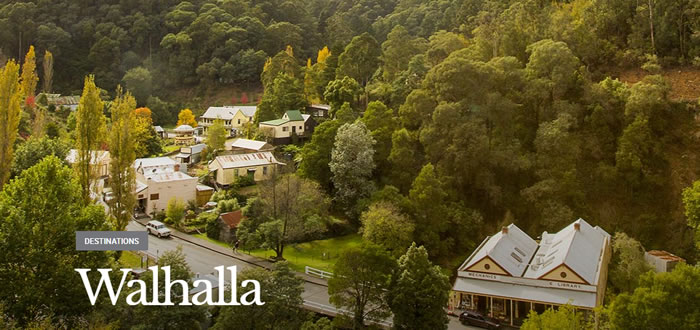Walhalla - Gold Mining Town |

The remains of the gold mining town of Walhalla are situated in a steep narrow mountain valley in Gippsland, about 185 km east of Melbourne.
In late 1862 alluvial gold was discovered here by a party of prospectors led by Ned Stringer. A rush to the creek, named after Stringer, quickly resulted. Quartz reefs were soon found and numbers of mining companies registered. The main reef, Cohen's proved to be one of the richest in Australia. The Walhalla and the Long Tunnel were the two main mines initially. Walhalla is at the south of gold-bearing country extending from Jamieson, north of the dividing range.
Walhalla is a masterpiece - a beautifully maintained and lovingly restored historic goldmining town perfectly located in a narrow valley between hills now verdant but once almost totally denuded of their trees.
The mining companies which occupied the area cut down the trees to fuel their machines and laid 30 km of tram tracks out into the woods in order to facilitate the collection of timber.
It is a genuinely superb goldmining experience with the highlights being a tour of Long Tunnel Extended Gold Mine and a journey on the Walhalla Goldfields Railway. It is a place to mooch and savour.
A sublime historic experience in a very beautiful setting.
Origin of Name: Stringer's Creek
Walhalla was originally named Stringer's Creek, after the creek that runs through the valley, but in 1869 the name was changed to Walhalla. The present name seems to come from Valhalla, the hall of immortality in Norse mythology where heroes reside after being slain in battle. There was a gold mine in the area that was called Walhalla. The name of the town is pronounced with a "W".
Discover the Goldfields
Get a taste of the gold fever that hit Victoria when gold was discovered in the 1850s, propelling the remote colony onto the world stage. At one stage, the gold output was greater than in almost any other country in the world. Miners arrived in the thousands, with townships popping up overnight and the riches laying the foundations for Victoria's future.
The best place to witness the legacy of the gold rush is in Victoria's Goldfields region, where ornate buildings, historic gardens and a Chinese heritage proudly proclaim the discovery of gold. Ballarat, Bendigo and Castlemaine have some of Victoria's best examples of the architecture that gold built, while Maldon, Dunolly and Talbot have exquisitely preserved Victorian streetscapes. Wherever you stop around the Goldfields, there's a strong sense of this rich past.
Things to See and Do
Check out the excellent guide at www.aussietowns.com.au that includes Walhalla Heritage Walk, The Grand Junction ,
Walhalla Fire Station, The office of the Walhalla Chronicle, Walhalla Post & Telegraph Office, Walhalla Cemetery, Bank of Victoria, Walhalla Mechanics' Institute and Spetts Cottage.
Download the excellent map at www.visitwalhalla.com. I
Tours and Experiences
The Long Tunnel Extended Mine
The Long Tunnel Extended Mine, which operated between 1871 and 1911, was the most successful goldmine in Victoria and one of Australia's richest, with 13.7 tonnes of gold being extracted over the years.
Guided tours are conducted weekdays, weekends and holiday periods. For details tel: (03) 5165 6259 or check out www.visitwalhalla.com.
Walhalla Goldfields Railway
The original Moe to Walhalla railway was opened in 1910 and closed in 1944. In 1993, a group of enthusiasts started to rebuild the most spectacular section of the line from the Thomson River up Stringers Creek Gorge to Walhalla. Trains returned to Walhalla in 2002 and now the Walhalla Goldfields Railway operates every Saturday, Sunday and Wednesday as well as during public holidays and daily during school holidays [see timetable at www.walhallarail.com.au].
Train Times: Saturday, Sunday and Wednesday; Daily from Boxing Day to 2nd weekend in January; Daily over Easter and Easter school holidays; Daily during Sept/Oct school holidays; Public holidays [excluding Christmas Day].
Depart Walhalla 11.00 am, 1.00 pm, 3.00 pm. Depart Thomson 11.40 am, 1.40 pm, 3.40 pm. Check https://www.walhallarail.com.au/index.php for details or tel: (03) 5165 6280.
Windsor House B&B
Now a guest house-B&B, Windsor House, with its thick walls, steep, gabled roof and wine cellar carved out of the cliff, was built in 1878. Located on Right Hand Branch Road, it was built by Johannes Gloz, a local miner, and his son, who also handmade the 90,000 bricks which form the house's structure. It is now listed by the National Trust. For more information check out windsorhousewalhalla.com.au.
Interesting Walhalla Facts
It took 90,000 homemade bricks to build a bed and breakfast
Due to Walhalla's mountain location, non-wooden building supplies were hard to come by. So when one resident decided to build an all brick house in the 1890s, the bricks all had to be handmade. The structure still stands today and operates as The Windsor House Bed & Breakfast.
The journey to the bottom of the mine was relatively quick
How long did it take the miners to descent through darkness to the bottom of the Long Tunnel Mine using 1800s technology? Just three minutes.
The most prolific gold mine is over four times deeper than the Eureka Tower is tall
The Long Tunnel Gold Mine sure lived up to its name. Extending over 1,120 metres underground, this mine was one of the most prosperous in Australian history.
Walhalla had electric street lights installed before Melbourne, then it lost electricity
With an influx of riches, the town had the funds for local projects including electric streetlights. The streetlights were powered by a generator at the mine, when the mine closed, Walhalla was plunged into darkness. Main electricity was finally connected to Walhalla in December 1998 making it that last place in Australia with a reticulated electricity supply.
The town's war memorial is dated incorrectly
When Walhalla's gold dried up, Australia was in the midst of combat in World War I. The town's population began to dip to near zero and the last ones out were eager to memorialize the locals who had died in battle. So, they built a monument before the end of the war and took a guess on when the conflict would end. The monument still stands today and reads: "In honor of the men of the Shire of Walhalla who enlisted to fight for the Empire. 1914 - 19." World War I ended in 1918. There are no names on the memorial as the final toll from the war was not known.
Residents once accepted vegetable shipments in coffins
With Walhalla's deep mountain location, shipping goods into town wasn't cheap. So when spacey coffins came from the city, they were usually stuffed with vegetables. Many of those coffins (minus the vegetables) now lie buried in Walhalla's mysterious mountainside graveyard.
There's a mountaintop cricket ground above the town
In the early 1900s, Walhalla featured a top-class cricket team that once defeated the prestigious Melbourne Cricket Club in a famous match. The pitch is still accessible on foot via a steep trail that leads to a cleared mountaintop. This special ground even hosts an occasional match.
The local fire station is the only one of its kind in the world
Building space was hard to come by in the tight valley where Walhalla sits. So when the town grew big enough to need a central fire station, the station was built directly over a river. It's now the only fire station on the planet that's built over a river.
The gold harvested under the town totaled 72 tonnes
That's more weight in gold than the weight of a Boeing 737. When totaled up, this gold would be worth around 5.8 billion GBP today. In it's prime, Walhalla was booming.
Total hotels: Two (But one is just a bar)
Looking to spend the night in Walhalla? The Star Hotel is your place. The hotel is a replica of gold-era's Star Hotel that was destroyed by fire and allows visitors to stay overnight in this uniquely historic town. Meanwhile, The Wally Pub serves cold beer just down the road.
It is one of the least-populated towns in the world
Walhalla has kept its post office operational, which means it technically qualifies as a town. With just 20 residents, it is one of the smallest official towns in the world. Once the town's gold ran out, people left with it. Today, only 20 permanent residents reside in Walhalla, with most of them dedicated to keeping the town preserved and open for visitors.
12 crazy facts about Walhalla
Source: australiaroadtrip.co.uk
Location
Walhalla is located 185 km east of Melbourne via the Princes Highway and the Moe-Walhalla Road.
Useful Websites
There is an excellent website at www.visitwalhalla.com.
❊ Address ❊
⊜ Moe-Walhalla Road Walhalla View Map
❊ Web Links ❊
➼ www.visitwalhalla.com➼ www.victorianplaces.com.au
➼ www.visitvictoria.com
➼ www.wikipedia.org
➼ www.visitwalhalla.com
❊ Also See... ❊
➼ Walhalla Goldfields Railway
Trending HOT
Things to see, hear & do this weekendMake the most of your weekend in Melbourne with these fabulous events. No city does it better than Melbourne, so get out and discover the very best shows, festivals, ..
Australian Open 2026 - Tennis
The countdown to the Australian Open 2026 is on! The start of the sporting year in Melbourne means only one thing - the Australian Open. Monday 12th January 2026 ..
Update Page








